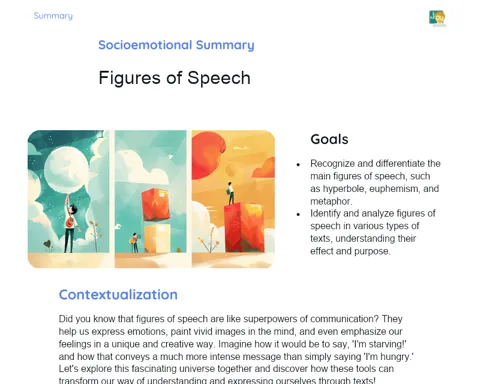INTRODUCTION
Relevance of the Topic
Adverbs and adverbial phrases are essential components in the construction of our language. These elements are responsible for modifying verbs, adjectives, and even other adverbs, enriching the expression of ideas and providing nuances of meaning to communication. They are crucial for the elaboration of more complete and structured sentences, playing the role of detailing the action, condition, manner, place, and time, among other aspects that provide a deeper understanding of the described situations.
Contextualization
Although the teaching of adverbs and adverbial phrases is introduced in the early years of basic education, in the 7th grade of Elementary School the subject should be seasonally reinforced, as this structure is fundamental for the development of more complex reading and writing skills, as well as the acquisition of more advanced linguistic abilities.
Understanding these concepts allows students to develop deeper text analyses and express themselves more precisely and sophisticatedly. The study of Portuguese is not limited to grammar. It is through it that students expand their possibilities of expression and better understand the nuances of the language, which is essential not only for fluency in Portuguese but also for learning other languages.
THEORETICAL DEVELOPMENT
Components
-
Adverb: An invariable word that modifies the meaning of the verb, the adjective, and the adverb itself, indicating various circumstances, such as place, manner, doubt, affirmation, negation, time, among others. It can completely change the meaning of a sentence depending on its application.
- Ex: I run quickly (manner). I run always (time). I run here (place).
-
Adverbial Phrase: It is the union of two or more words with the value of an adverb. Like adverbs, adverbial phrases modify the meaning of verbs, adjectives, and adverbs, indicating the same circumstances.
- Ex: I run in the morning (time). I run with speed (manner). I run at home (place).
-
Classification of adverbs and adverbial phrases: Adverbs and adverbial phrases are classified according to the circumstances they express: place, time, manner, intensity, negation, doubt, affirmation.
Key Terms
-
Circumstance: The situation or condition in which something occurs. In the case of adverbs and adverbial phrases, it refers to the modification that these words provide to the action expressed by the verb.
-
Invariable: Words that do not undergo changes in gender, number, or degree. Adverbs are an example of invariable words.
-
Compound Words: are formed by more than one element. In the case of adverbial phrases, they are compound words with the value of an adverb.
Examples and Cases
-
Regarding the adverb, we can analyze the following sentence: "The student studied a lot for the test." The adverb "a lot" is intensifying the verb "studied", indicating the intensity of the study.
-
The adverbial phrase can be understood in the example: "The child played with joy." Here, "with joy" is an adverbial phrase, as it is a compound expression (with + joy) and is performing the function of an adverb of manner, explaining how the child played.
DETAILED SUMMARY
Relevant Points
-
Meaning and Function of Adverbs: It is essential to recognize that adverbs are invariable words that act by modifying the meaning of the verb, the sense of the adjective, and even the adverb itself. They perform their function by indicating various circumstances such as place, manner, doubt, affirmation, negation, and time.
-
Operation of Adverbial Phrases: Although adverbial phrases are a combination of two or more words, they function with the value of a single adverb. Therefore, they also modify the meaning of verbs, adjectives, and adverbs, indicating the same circumstances as adverbs.
-
Classification of Adverbs and Adverbial Phrases: It is crucial to understand that adverbs and adverbial phrases are classified according to the circumstances they aim to express. Among them, we find: place, time, manner, intensity, negation, doubt, and affirmation.
Conclusions
-
Relevance of Adverbs and Adverbial Phrases: Adverbs and adverbial phrases are key pieces in the structuring of sentences and in the elaboration of texts. Their mastery and correct application allow for more precise, detailed, and varied expression, directly reflecting on the enrichment of the language.
-
Variety of Adverbs and Adverbial Phrases: There is a wide range of adverbs and adverbial phrases, each with its own nuances of meaning, thus expanding the possibilities of representing circumstances in the linguistic context.
Exercises
- Identify and classify the adverbs present in the following sentences:
- "John worked a lot today."
- "Maria always runs on the beach."
- "The cat is here."
- Write a sentence containing an adverbial phrase and identify the circumstance it expresses.
- Replace the adverbs in the sentences from exercise 1 with adverbial phrases that express the same circumstance.



